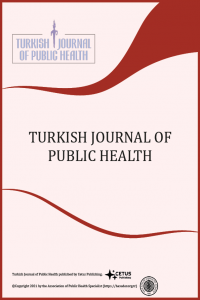Elektrik alan seviyeleri ve halk sağlığı açısından değerlendirilmesi: Samsun şehir merkezi örneği
Elektromanyetik alan, elektrik alan şiddeti, baz istasyonu, limit değerler, halk sağlığı
Electric field levels and its evaluation from the view of public health: Samsun city center example
Electromagnetic field, electric field strength, base station, limit values, public health,
___
- 1. Statista. Forecast of mobile phone users worldwide from 2013 to 2019. [online]. Available at: www.statista.com/statistics/274774/fo recast-of-mobile-phone-usersworldwide/. Accessed October 10, 2017. 2. WHO International Agency for Research on Cancer Monograph Working Group. Carcinogenicity of radiofrequency electromagnetic fields. Lancet Oncol 2011; 12(7): 624-626. 3. Van Deventer E, Van Rongen E, Saunders R. WHO research agenda for radiofrequency fields. Bioelectromagnetics 2011;32(5):417421. 4. Lin JC. Are radio frequency or mobile phone electromagnetic fields possibly carcinogenic to humans?. URSI Radioscience Bulletin 2010;340:53-54. 5. FCC. Wireless devices and health concerns. [online]. Available at: https://www.fcc.gov/consumers/guides /wireless-devices-and-healthconcerns/. Accessed October 10, 2017. 6. FDA. Reducing Exposure: Hands-free kits and other accessories. [online]. Available at: https://www.fda.gov/RadiationEmittingProducts/RadiationEmittingPro ductsandProcedures/HomeBusinessand Entertainment/CellPhones/ucm116293. htm. Accessed October 10, 2017. 7. Prasad M, Kathuria P, Nair P, Kumar A, Prasad K. Mobile phone use and risk of brain tumours: a systematic review of association between study quality, source of funding, and research outcomes. Neurol. Sci 2017; 1-14. 8. Hardell L, Carlberg M, Mild KH. Epidemiological evidence for an association between use of wireless phones and tumor diseases. Pathophysiology 2009; 16: 113-122. 9. Dode AC, Leão MM, Tejo Fde A, et al. Mortality by neoplasia and cellular telephone base stations in the Belo Horizonte municipality, Minas Gerais state, Brazil. Sci. Total Environ 2011; 409: 3649-3665. 10. ICNIRP Guidelines, “Guidelines for Limiting Exposure to Time-Varying Electric, Magnetic, and Electromagnetic Fields (up to 300GHz)”, International Commission on Non-Ionizing Radiation Protection, Health Physics 1998. p.494522. 11. Information and Communication Technologies Authority of Turkey, “Ordinance change on By-Law on Determination, Control and Inspection of the Limit Values of Electromagnetic Field Force from The Electronic Communication Devices According to International Standards”, Law no.29497, 9 October 2015. 12. Urbinello D, Joseph W, Verloock L, Martens L, Röösli M. Temporal trends of radio-frequency electromagnetic field (RF-EMF) exposure in everyday environments across European cities. Environ. Res 2014;134:134-142. 13. Sagar S, Struchen B, Finta V, Eeftens M, Röösli M. Use of portable exposimeters to monitor radio frequency electromagnetic field exposure in the everyday environment. Environ. Res 2016;150:289-298. 14. Engiz B. K, Kurnaz Ç. Long-term electromagnetic field measurement and assessment for a shopping mall. Radiat. Prot. Dosim 2017;175(3):321-329. 15. Kurnaz Ç. An emprical modelling of electromagnetic pollution on an university campus. App. Comput. Elctromagn. Soc. Express J 2016; 1(2):76-79. 16. Kurnaz Ç, Bozkurt MC. Measurement and evaluation of electromagnetic pollution levels in Ünye district of Ordu. Journal of New Res. Sci 2016;5(12):149-158. 17. Hassoy H, Durusoy R, Karababa A.O. Baz istasyonlarının olası sağlık etkilerine ilişkin bir güncelleme. Türkiye Halk Sağlığı Dergisi 2012;10(3). 18. www.pmm.eu/includes/sendfile.asp?no mep=Field_Probe. Accessed October 10, 2017.
- Başlangıç: 2003
- Yayıncı: Halk Sağlığı Uzmanları Derneği
Merve KARAÇALI, Raziye ÖZDEMİR
Web tabanlı bir araştırmanın düşündürdükleri üzerinden LGBTİ+ sağlığı
Yeşim YASİN, M. Müjde ÇEBİ, İpek ŞAPÇI
Elektrik alan seviyeleri ve halk sağlığı açısından değerlendirilmesi: Samsun şehir merkezi örneği
Sagvan Hasan ALİ, Bakhtiyar Ahmed RASHEED, Tariq Salman AL-HADİTHİ
Yaşlılarda yaşam kalitesini etkileyen faktörler
Özgür ÖZERDOĞAN, Buse YÜKSEL, Merve ÇELİK, Sibel OYMAK, Coşkun BAKAR
Bütünsel sağlık için yeni bir kavramsal çerçeve
Bir ilçede bulunan okul kantinlerinin hijyen koşulları ve gıda güvenliği açısından değerlendirilmesi
Leyla ÜÇEŞ HARMANOĞULLARI, Gülçin YAPICI
The effects of personality traits and other variables on the specialty choices of resident doctors
Nalan AKİS, P. Eylul TANERİ, Guliz AVSAR BALDAN, Aysegul AYDİN
